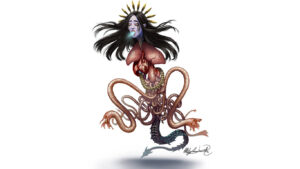Table of Contents
Origins
The Aspidochelone’s origins trace back to various cultures and time periods, its name drawing from Greek and Middle English sources. In Greek mythology, “Aspidochelone” springs from “aspis,” signifying a shield, and “chelone,” denoting a sea turtle. Middle English commonly wrote it as “aspidechelone.” Medieval bestiaries, compendiums of fantastical creatures, plants, and minerals, played a significant role in disseminating the Aspidochelone’s story.
In Greek Mythology
The ancient Greek word “aspis,” meaning “shield,” provides the foundation for the Aspidochelone’s Greek origins. Its association with the creature arises from its deceptive likeness to a floating island, resembling a shield-shaped landmass on the water’s surface. Additionally, the Greek term “chelone,” referring to a sea turtle, plays a vital role in naming the creature.
The concept of a colossal sea creature or island capable of ensnaring sailors and ships serves as a cautionary tale rooted in Greek mythology. Greek mythology abounds with narratives of seafarers confronting perilous challenges and encountering formidable sea monsters during their voyages. The Aspidochelone epitomizes the hazards and uncertainties of the open sea, where appearances can deceive, and the boundary between reality and illusion blurs.
In Middle English
The Middle English spelling of the creature’s name, “aspidechelone,” highlights its presence in medieval European literature and folklore. Throughout the Middle Ages, various written forms, including bestiaries, travelogues, and manuscripts, disseminated stories of mythical creatures.
Medieval Bestiaries

One significant medium through which the Aspidochelone’s story was disseminated was the medieval bestiary. Moreover, these bestiaries were compendiums of fantastical creatures, plants, and minerals, often accompanied by moral or allegorical interpretations. Thus, the Aspidochelone found its place among these eclectic collections of mythical beings.
In the context of bestiaries, the Aspidochelone served as a symbolic representation of deceit and temptation. Its ability to lure sailors with the allure of a lush island before revealing its true, monstrous nature was a powerful metaphor for the dangers of succumbing to worldly temptations and veering off the path of righteousness.
Family
Within the realm of mythical creatures, the Aspidochelone belongs to a unique and mysterious lineage. Due to its oceanic habitat and monstrous proportions, it often associates with other sea monsters like the Kraken, Leviathan, and Scylla. However, the Aspidochelone stands apart in its distinctive characteristics, making it a creature all its own.
Appearance
Transitioning from the description of the Aspidochelone’s appearance and characteristics, the legendary sea creature is a pivotal figure in medieval bestiaries and folklore. Moreover, described as a colossal sea turtle or sea monster, its immense size often leads to it being mistaken for an island or a massive floating whale. Derived from the Greek words “aspis” (shield) and “chelone” (turtle), its name underscores its resemblance to a giant turtle with a shield-like shell.
This deceptive appearance lures unwary sailors and adventurers who anchor their ships on its back, believing they have found a safe harbor. However, as the Aspidochelone senses the weight of the ships, it undertakes a sinister transformation, submerging beneath the waves, ultimately drowning the sailors and consigning their ships to a watery grave.
Medieval literature and moral stories deeply engrain the Aspidochelone’s legend in the tradition of mythical sea monsters, frequently using it as a cautionary tale. It stands as a stark warning to those who place blind trust in appearances, reminding them of the hidden perils lurking beneath the surface.
Abilities

The imaginative storytelling of the time shapes these abilities and traits, which lack grounding in reality. Here are some of the key abilities and characteristics associated with the Aspidochelone in folklore:
Gigantic Size – Many people describe the Aspidochelone as an enormous sea creature that inspires awe and intimidation due to its immense size. Its size is so vast that it can easily be mistaken for an island or a floating landmass.
Deceptive Appearance: The most notable ability of the Aspidochelone is its ability to deceive sailors and adventurers. Its back is said to be covered in sand, rocks, and soil, giving it the appearance of an inviting and habitable island. This deceptive appearance lures unsuspecting sailors who anchor their ships on its back, believing they have found safe harbor.
Submersion: Once ships and sailors have anchored on its back, the Aspidochelone uses its strength to submerge beneath the water, dragging the ships and their occupants down with it. This act leads to the drowning of those who were deceived by its appearance.
Symbols
First and foremost, it symbolizes deception and illusion. The creature’s ability to disguise itself as an inviting island serves as a cautionary tale about the dangers of trusting appearances without a thorough investigation.
Furthermore, the Aspidochelone symbolizes the unforgiving and unpredictable nature of the sea. Many ancient seafaring cultures revered and feared the sea equally, and the Aspidochelone’s role as a maritime menace emphasized the notion that the ocean held both beauty and peril.
Related Myths and Stories
Various mythologies and medieval writings scatter tales of the Aspidochelone. One renowned account exists in the “Physiologus,” an early Christian text from the second century AD. It describes the Aspidochelone as a monstrous sea creature that lures sailors with its alluring appearance before devouring them.
The Aspidochelone also makes appearances in Arthurian legends. In Sir John Mandeville’s “The Travels of Sir John Mandeville,” a popular medieval travelogue, the creature is encountered by the eponymous explorer. Mandeville’s account emphasizes the treacherous nature of the Aspidochelone and its ability to trap the unwary.
The Deceptive Depths of the Aspidochelone

In the distant waters of the medieval world, there existed a legendary creature known as the Aspidochelone. This enormous sea turtle-like being was unlike any other in the vast ocean. With a back adorned in sand, rocks, and soil, it bore a deceptive visage, resembling a serene and inviting island afloat on the waves.
Sailors and adventurers, in their endless quest for safe harbor and respite from the relentless sea, would often come across the Aspidochelone. Captivated by the sight of what they believed to be an idyllic island, they anchored their ships upon its back. The crew, seeking refuge from their tumultuous journeys, would disembark, kindling fires and reveling in the false comfort of solid land.
Unbeknownst to these unsuspecting travelers, the Aspidochelone was far from an island of safety. When enough weight had been placed upon its colossal shell, it would begin to stir beneath the surface of the water. Slowly, it would sink into the depths, taking the ships and their inhabitants with it.
The once-celebrated island of respite would reveal its treacherous nature, submerging entirely beneath the waves. Panic would ensue as sailors and adventurers found themselves trapped, their vessels dragged into the abyss. The once-promised sanctuary had become a watery grave.
Conclusion:
The Aspidochelone, with its deceptive allure and deadly intent, stands as a captivating and cautionary figure in the world of mythical creatures. Furthermore, born from the depths of ancient myths and perpetuated through the ages, this colossal sea monster serves as a reminder of the dangers that lie beneath the surface of the seemingly serene sea. Additionally, its ability to transform into a deadly trap, its mesmerizing appearance, and its role in various cultures make it a truly extraordinary and enduring creature of legend. Hence, the Aspidochelone continues to inspire awe and fascination as it sails on through the seas of human imagination.
Similarities
The Aspidochelone shares some similarities in appearance and abilities with other mythical sea creatures and folklore entities. These creatures, often characterized by their deceptive appearances, massive sizes, and the ability to lure or trap sailors, have counterparts in various mythologies:
The Kraken, a legendary sea monster from Scandinavian folklore, often appears in portrayals as a colossal, tentacled creature lurking beneath the ocean’s surface. Similar to the Aspidochelone, it possesses the capacity to create illusions and drag ships and sailors down to the depths.
In Norse mythology, Jörmungandr, a massive serpent encircling the world, achieves such immense size that observers could mistake it for an island or landmass when seen from a distance. It poses a formidable threat to sailors and ships.
Scylla and Charybdis: In Greek mythology, the narrow strait was inhabited by two sea monsters, Scylla and Charybdis. Scylla, often depicted as a multi-headed creature, would attack ships passing too closely, while Charybdis was a whirlpool capable of swallowing entire vessels.
Sirens: In Greek mythology, Sirens, enchanting creatures with beautiful voices, lure sailors to their doom with their songs. While they may lack the massive size of the Aspidochelone, they share the theme of deception and danger at sea.
Sea Serpents: Various cultures have legends of sea serpents or sea dragons, described as long, serpentine creatures resembling snakes or dragons. Sailors sometimes associate these mythical beings with creating treacherous conditions.
FAQ
Why is it famous?
The Aspidochelone is famous for its ability to deceive sailors by appearing as an inviting island, only to submerge and drown both sailors and their ships when they anchor on its back.
What does its name mean?
The name "Aspidochelone" is derived from Greek words: "aspis" meaning shield and "chelone" meaning turtle, reflecting its appearance.
Is the Aspidochelone real?
No, the Aspidochelone is purely a mythical creature and does not exist in reality. It is a product of medieval storytelling and symbolism.
What is the moral lesson associated with the Aspidochelone?
The legend of the Aspidochelone is often used as a cautionary tale, warning against trusting appearances without considering potential dangers lurking beneath the surface.




